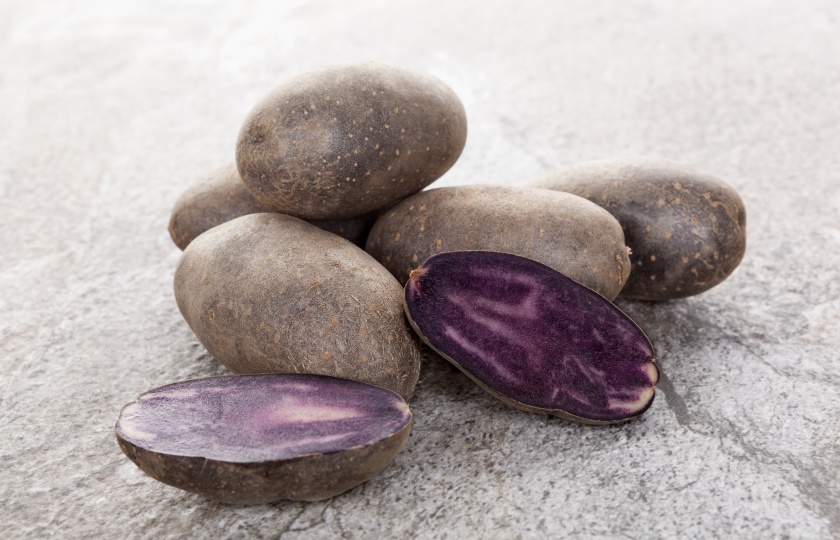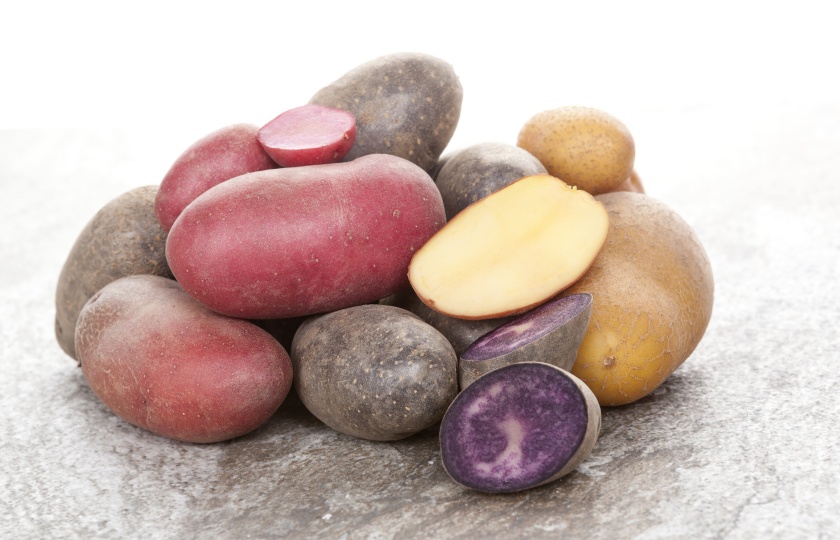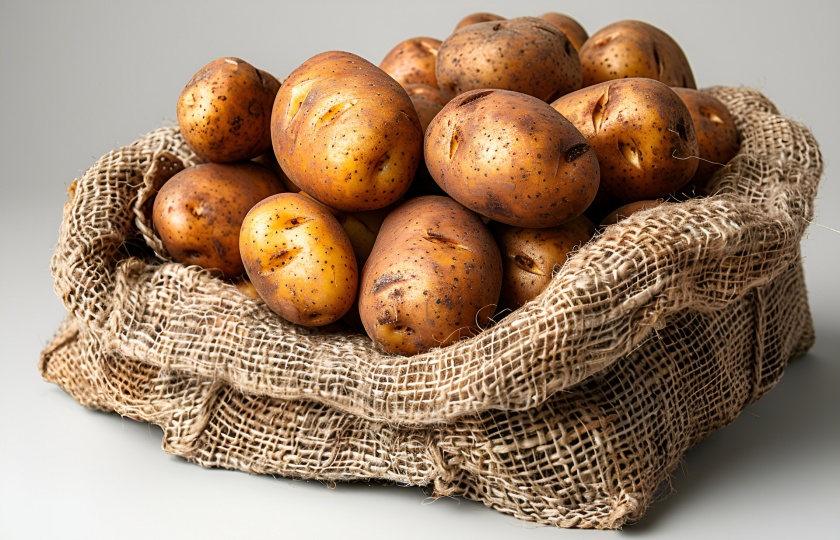Here’s a detailed comparison of Purple potatoes vs white potatoes nutrition

When I went to the market to buy potatoes, I found white potatoes and purple potatoes. I didn't know which one to choose. After research, I finally knew the difference between the two. Now I will share with you the nutritional comparison of purple potatoes and white potatoes.
Purple potatoes vs white potatoes nutrition
Purple potatoes and white potatoes are common potato varieties. There are some differences in the nutritional content of the two, as follows:
Purple potatoes
Anthocyanins: Purple potatoes contain a large amount of anthocyanins, which is a powerful antioxidant that helps resist oxidative stress and protect cells from damage.
High protein: Purple potatoes are rich in high protein, with about 2.3 grams of protein per 100 grams of purple potatoes, which is enough to meet the body's protein needs.
Low fat: Purple potatoes have a low fat content, with only 0.1 grams of fat per 100 grams of purple potatoes, which is suitable for people who need to control fat intake.
Multiple vitamins and minerals: Purple potatoes contain a lot of vitamin C, B vitamins, calcium, iron, phosphorus, potassium, magnesium, etc., which help to enhance immunity and promote cardiovascular health.
White potatoes
High starch: White potatoes contain a lot of starch, with a carbohydrate content of 16.5%, providing a stable source of energy.
Vitamin C: White potatoes are rich in vitamin C, which helps to enhance immunity and promote iron absorption.
Dietary fiber: White potatoes contain a certain amount of dietary fiber, which helps to promote intestinal peristalsis and improve digestion.
Nutrition comparison:
Similarities: Both purple potatoes and white potatoes are rich in carbohydrates, vitamin C and dietary fiber, which help to provide energy and promote digestion.
Differences: Purple potatoes contain more anthocyanins and proteins, have stronger antioxidant effects and higher protein content; while white potatoes have a higher starch content and are suitable for people who need energy.
Are purple potatoes better for you than white potatoes?
From the above, we can know that purple potatoes and white potatoes each have their own advantages, and we cannot one-sidedly say which one is healthier.

Purple potatoes are rich in anthocyanins, which is the advantage of purple potatoes. Anthocyanins can effectively fight free radicals and are very helpful in preventing cardiovascular diseases and delaying aging. At the same time, purple potatoes also contain a large amount of vitamin C, potassium, dietary fiber and other nutrients. Eating an appropriate amount can help enhance immunity, maintain normal heart function and promote intestinal peristalsis.
White potatoes have a high content of dietary fiber, which can help improve the intestinal environment of the human body and is very effective for intestinal problems such as constipation. At the same time, white potatoes also contain a large amount of beta-carotene. These substances can be converted into vitamin A in the human body and are very good for vision and skin health. Moreover, white potatoes are also a good source of carbohydrates and can provide energy for the human body.
Therefore, purple potatoes and white potatoes both have their own unique nutritional value. Which one is better depends on personal health needs and dietary preferences. If you are more concerned about antioxidant aspects, then purple potatoes may be more suitable for you; if you want to focus on taking care of the intestines or vision, white potatoes are more suitable.
Should you eat the skin of purple potatoes?
The skin of purple potatoes can be eaten, but whether to eat it or not is up to you.
What you need to know is that the skin of purple potatoes contains a large amount of vitamins and dietary fiber substances. These substances can help promote the peristalsis of the human gastrointestinal tract and are beneficial to human digestion.
At the same time, purple potatoes also contain a large amount of anthocyanins. This substance has a strong antioxidant effect. Eating an appropriate amount can help delay aging and remove free radicals in the body.
If you want to eat potato skins, you need to pay attention to cleaning them carefully, because potato skins carry soil and sometimes there are residual pesticides and other harmful substances, which are harmful to human health.
Of course, if you don't like eating skins, you can peel them off. It doesn't affect eating.
Are purple potatoes a Superfood?
Purple potatoes can be called superfoods because purple potatoes contain a large number of nutrients beneficial to the human body.First of all, from a nutritional point of view, purple potatoes contain a large amount of anthocyanins. This substance can effectively remove free radicals in the body. Free radicals are "little devils" that cause aging and many diseases. At the same time, anthocyanins can also protect the human eyes, make vision healthier, and also have a certain protective effect on the cardiovascular system.
Secondly, purple potatoes also contain a large amount of dietary fiber. This substance is very friendly to human intestinal health. After eating purple potatoes, dietary fiber is like a small broom, cleaning the intestines cleanly, promoting intestinal peristalsis and preventing constipation.
And the content of vitamins and minerals in purple potatoes is also relatively rich. Eating an appropriate amount can help maintain potassium, which is necessary for normal physiological functions and is very important for heart and blood pressure regulation; there is also vitamin C, etc., which can enhance immunity.
But it should be noted that although purple potatoes have so many advantages, you can't rely on it alone. In daily diet, you still need to combine various foods so that the nutrition can be more balanced.
Which color potato is healthiest?
I personally think that purple potatoes are one of the healthiest choices because purple potatoes are rich in nutrition and have many unique characteristics beneficial to health.

First of all, purple potatoes are rich in anthocyanins. This is a powerful antioxidant with anti-inflammatory and anti-aging effects. It helps protect cells from free radical damage, reduce the risk of chronic diseases, and enhance the immune system. It is more advantageous in terms of antioxidant than potatoes of other colors.
Secondly, the dietary fiber content of purple potatoes is relatively high, especially in the skin. Fiber is very important for promoting digestion, increasing satiety and helping to control weight. The combination of the skin and the inside of purple potatoes makes it a very good source of dietary fiber.
In addition, the low glycemic index (GI) of purple potatoes is also a notable health advantage. Low GI foods help stabilize blood sugar and avoid energy decline or hunger caused by excessive blood sugar fluctuations. This is an ideal choice for people with diabetes or those who pay attention to blood sugar control.
Although purple potatoes have high nutritional value, pay attention to cooking methods. Try to choose healthy methods such as steaming, boiling and baking, and avoid frying to maximize the retention of its nutritional components.
Red potatoes vs white potatoes for diabetics
There are some differences in the effects of red potatoes and white potatoes on diabetic patients, mainly reflected in the following aspects:
Starch content and glycemic index (GI)
Red potatoes: Red potatoes have a higher starch content, and the glycemic index (GI) is about 60-65. This means that red potatoes may cause blood sugar to rise rapidly after eating.
White potatoes: The starch content is lower, and the glycemic index (GI) is about 55-60. White potatoes have less impact on blood sugar and are more suitable for diabetic patients.
Dietary fiber content
Red potatoes: The dietary fiber content is lower, about 1-2%. Dietary fiber helps slow down the rate of blood sugar rise, but red potatoes contribute less in this regard.
White potatoes: The dietary fiber content is higher, about 2-3%. The higher dietary fiber content helps better control blood sugar levels.
Nutritional components
Red potatoes: Rich in anthocyanins, proteins, trace elements, etc., with high nutritional value. However, for diabetic patients, its high starch content may bring challenges to blood sugar control.
White potatoes: Contain rich nutritional ingredients such as vitamin C and potassium. At the same time, due to its lower starch content, it has less impact on blood sugar and is more suitable for diabetic patients as part of the staple food.
Cooking methods and blood sugar control
Red potatoes: It is recommended to use cooking methods with low oil and low salt such as steaming and boiling to reduce the impact on blood sugar. Avoid high-fat cooking methods such as frying, because this will significantly increase the glycemic index.
White potatoes: Suitable for cooking methods such as vinegar-flavored and cold salad. These methods help maintain the crisp texture of potatoes and at the same time reduce the rate of blood sugar rise.
In conclusion, although both red potatoes and white potatoes are rich in nutrition, white potatoes have less impact on blood sugar due to their lower starch content and higher dietary fiber content, and are more suitable for diabetic patients. Although red potatoes have high nutritional value, due to their high starch content, diabetic patients need to pay attention to controlling the intake when eating and choose appropriate cooking methods to control blood sugar.























